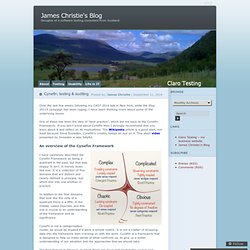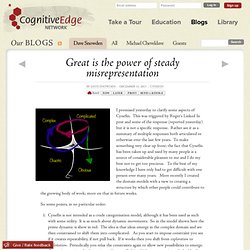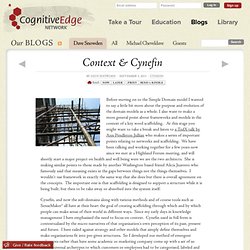

Of experts and expertise. A long time ago when I first created the Cynefin framework in its five domain form my focus was on knowledge management.

The first fully worked article looked at communities and deployment of knowledge and in those versions I talked about complicated (then called knowable) as the domain of experts. The context here was the then tendency to assume that all you needed to do to create a KM programme was create a taxonomy and set up a CoP programme.
CoPs were then held to be the best way to host and develop expert knowledge, so calling it the domain of experts made sense. Most people understand that to say that one domain is that of experts does not mean that expertise is not required in the others. The point is, and has always been, that in the complicated domain you can trust expert judgement. Of course expert bias is an issue where you are dealing with novelty or changed context as this quote from The invisible gorilla strikes again ( Drew, Vo & Wolfe Psychol Sci. File:Cynefin as of 1st June 2014.png - Wikimedia Commons.
Cynefin 101 – An Introduction. The purpose of this paper is to introduce the Cynefin model and its practices which can be used to address the uncertainty of the modern world.

The practices that are introduced can be used to compliment traditional approaches to programme and portfolio management. This provides a more comprehensive approach that reflects the needs of management in an ever more uncertain world. We have seen a couple of books appear on the issue of uncertainty over the last decade but neither have a comprehensive framework that allows us to deal with the increase in uncertainty of the modern world. If anyone is in doubt that traditional models are struggling to deal with modern market dynamics they only need to look at the demise of Monitor Group.
This was Michael Porter’s, the father of strategic analysis, company and used his market model. Cynefin, testing & auditing. Over the last few weeks following my CAST 2014 talk in New York, while the Stop 29119 campaign has been raging, I have been thinking more about some of the underlying issues.

One of these has been the idea of “best practice”, which led me back to the Cynefin Framework. If you don’t know about Cynefin then I strongly recommend that you learn about it and reflect on its implications. The Wikipedia article is a good start, not least because Dave Snowden, Cynefin’s creator, keeps an eye on it. This short video presented by Snowden is also helpful. Cynefin, testing & auditing. Complicated domain v45º. Great is the power of steady misrepresentation. I promised yesterday to clarify some aspects of Cynefin.

This was triggered by Roger's Linked In post and some of the response (reported yesterday) but it is not a specific response. Rather see it as a summary of multiple responses both articulated or otherwise over the last few years. To make something very clear up front; the fact that Cynefin has been taken up and used by many people is a source of considerable pleasure to me and I do my best not to get too precious. Cynefin: Distinguishing between sense-making and categorisation. I first encountered Dave Snowden and Cynefin back in 2003 when we were still working for IBM.

I felt an immediate resonance when I encountered the Cynefin Centre’s Complexity and Narrative based consulting methods as I never felt comfortable with the one-size-fits-all recipe-based consulting approaches I’d had to apply. The acknowledgement of the importance of context and that Best Practices are only valid within very specific boundaries was a breath of fresh air.
The Cynefin Centre produced a document with the “organising principles” or heuristics underlying their complexity-based consulting approach – I found them extremely useful, but they’ve fallen by the wayside over the years. I thought this might be a good time to resurrect them. There are 12 principles in 4 categories – I’ll unpack each in a series of posts. 1. “The classic consultancy two by two matrices are categorisation models. When dealing with complex systems, relational thinking is much more valuable than categorisation. Hammers, Nails, and a Cynefin Critique. Cynefin v45º complete. Today was a rest and relaxation day here in Tuscany.

I went for a swim at 0700, few others saw the light of day for several hours. Aside from a brief shopping trip and taking a millimetre or two of one tyre of the van getting it out of a tight situation its all being peaceful. If got a lot of reading done, cleared some emails and then settled down to complete the v45º domain models. The complex one is re-produced below but other than some very minor changes remains stable bar the 45º reorientation. The thing which took the time this afternoon was getting all four domain models up onto a single sheet with all the coherence and movement lines in the right place. Now the three dimensional version interested me when I saw it. So that means I can now put everything together into a single image as shown below.
Chaotic domain explained Simple domain explained Complicated domain explained Complex domain explained, but new illustration below Scaffolding aspects explained. Context & Cynefin. Before moving on to the Simple Domain model I wanted to say a little bit more about the purpose and evolution of the domain models as a whole.

I also want to make a more general point about frameworks and models in the context of a key word scaffolding. At this stage you might want to take a break and listen to a TedX talk by Ann Pendleton-Jullian who makes a series of important points relating to networks and scaffolding. We have been talking and working together for a few years now since we met at a Highland Forum meeting, and will shortly start a major project on health and well being were we are the two architects. She is making similar points to those made by another Washington based friend Alicia Juarrero who famously said that meaning exists in the gaps between things not the things themselves. I wouldn't use framework in exactly the same way that she does but there is overall agreement on the concepts. Complicated vs. Complex Part I: Why Is Scaling Up So Elusive in Development: What Can Be Done?